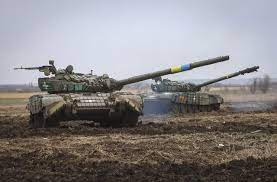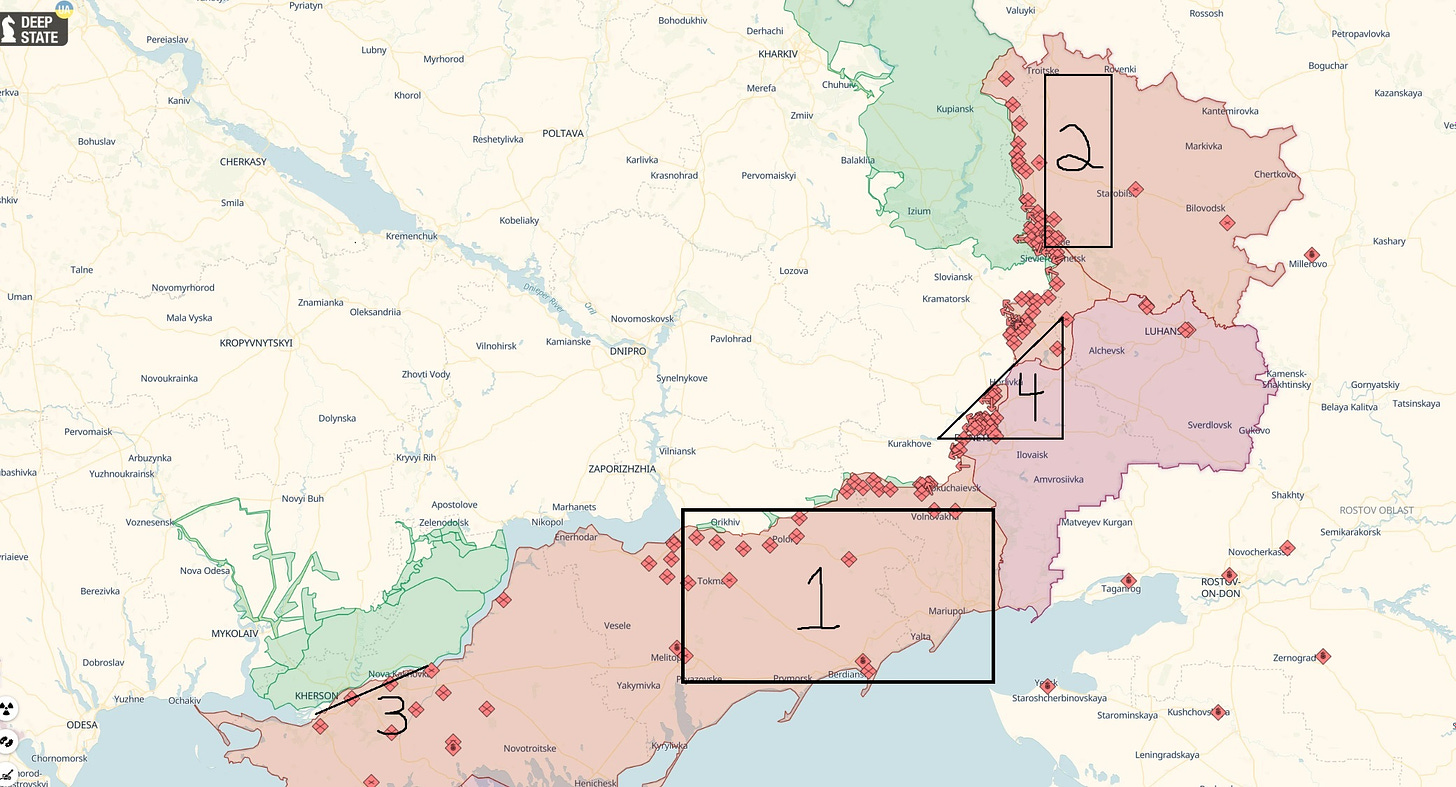It also tires out the units facing the expected attack. They cannot maintain peak readiness forever so a constant state of threat warning could eventually lead to a dismissal of the risk. Which is exactly when Ukraine could then strike.
Phillips O'Brien reports in his substack:
The purpose of the Ukrainians encouraging counteroffensive chatter (is) to let the Russians think the attack will be everywhere, so they can spread out their forces and (let) Ukraine find a weaker spot in the line. And let the Russians think the attack will come soon. That points to 1) The Ukrainian offensive might not be imminent as the Ukrainians will want to whittle down Russian forces as much as possible before starting. 2) The Ukrainians might not know where they will attack until closer to the jump-off time to decide. Always talking about the counteroffensive could tire the Russians, leading to heightened tension and then, if the attack doesnt happen for a while, the Russians might relax too muchIf a Ukrainian counteroffensive in the Spring/Summer of 2023 was supposed to be a secret—no one told the Ukrainians. The discussion of any such operation is practically ubiquitous across the country, with lots of speculations, part nervous and part anticipatory, of what it might entail. Indeed, it was hard to have a conversation with some people without it turning back to the possibility of a Ukrainian attack. Now, considering that the Ukrainian government and military is going to great lengths to drop hints about any counteroffensive, it could hardly be otherwise.In many ways, what the Ukrainian government is doing makes perfect sense. Since only a very small number of people actually know the details of the counteroffensive (and tbh even those people might not know the specific date yet or indeed the exact objectives as those are always flexible—see below) it helps to let everyone speculate endlessly. In the first case, it means that any chatter has to be disregarded—there are so many people (like me) wondering when this will start and where, and discussing its possibilities—that all the noise will obscure the real planning.
The second thing is that always talking about the counteroffensive could have an (admittedly small) tiring impact of the Russians. The above video by the Ukrainians is a perfect example of how to keep the Russians wondering—when and where will this start? Maybe soon? At first it can lead to heightened tension and then, if the attack doesnt happen for a while, the Russians might relax too much. So there certainly is a sense in encouraging all this talk—and I imagine that the Ukrainian government will continue to create the impression that the counteroffensive will start soon.
Finally its worth encouraging speculation because, as said above, the date and location of the counteroffensive is almost certainly more flexible than some might understand. Looking at major military offensives in the 20th and 21st centuries shows just how these can be changed and adapted quickly. Now, as a WWII historian, I hope you will indulge me a little shop-talk. If you look at some of the most famous offensives of the war, the German attacks on France (1940), the USSR (1941) and the Anglo-American invasion of France, D-Day (1944), you can see just how these things are not set in stone and can be adjusted significantly almost until the moment they start.
The German attack on France in 1940, with its terrible result of the German Army splitting the French Army in the Maginot Line from the British/French forces in Belgium was only worked out relatively late in the day. In an interesting echo of the present story of the leaks of intelligence in Washington, the early German plans for the attack on France (which resembled the Schlieffen Plan of 1914 with a wide sweep around the Allied armies) was actually revealed to allied planners. It was part of a process of a redrafting of the plan entirely, often called the Manstein Plan, to change the offensive significantly. Only in late February 1940 (two and a half months before the invasion happened) was the plan agreed that was eventually put into operation. And even then, the German operation was constantly being tweaked until the last minute.
The German Invasion of Barbarossa was originally planned to start in April-May 1941. However the start date was pushed back by approx 2 months because of Mussolini’s catastrophic invasion of Greece. As Mussolini’s armies were driven back into Albania in 1941, Hitler wanted to stabilize the situation. When Yugoslavia was considered unreliable by the Nazi dictator, he ordered invasions of both Yugoslavia and Greece—diverting forces that were being prepared for Barbarossa. These twin attacks started in April and as such, even with their rapid military success, the invasion of the USSR was put back to 22 June.
D-Day. This was an invasion that almost had a major delay. Originally conceived as an operation that was to start on in May 1944, the forces were not ready to go and the tide was not right until early June. The expected new start date was June 5, but weather was so bad that day it was delayed until June 6. Even then the weather was poor enough that it was not clear that the attack would proceed. If it was unable to be launched on June 6th, it would have been delayed for weeks until the tides were once again right.
Long story short (and this piece is heading down a road unexpected) the start of offensives and even their methods are subject to pretty late changes and adjustments. And that is almost certainly the case for the Ukrainian counteroffensive. It could start soon, it could not start for many months—and in the meantime all the chatter actually helps the Ukrainian planners.
Aim of Ukrainian CounteroffensiveThere was also a great deal of speculation in Ukraine about where any counteroffensive might aim. There were some who were convinced it would head to the Black Sea Coast, stretching down somewhere between Melitopol and Mariupol in the first instance (1). Other people said that this was too predictable, and the Ukrainians would attack on the north east of the line (2). Other people were wondering about possible feints or even assaults over the Dnipro around Kherson (3). Some even wondered if the right place to attack would be Bakhmut or one of the other cities where Russian forces have been banging their heads against the wall to make strategically insignificant gains for months (4). Looking at this map Ive created—you can see where all these might occur. (Apologies for my poor skills)
Like with the date, all this speculation is of course irrelevant as only the Ukrainian high command knows/decides—but at the same time the more speculation the better. The Ukrainians want the Russians to disperse forces over the entire line, thinning out any defensive line as much as possible.
I can say I haven’t the slightest idea where it will happen. Back in September/October 2022, when I started thinking about this campaign. I thought the Russians might be rational and take up a solid defensive line and try to make the Ukrainians attack them
https://twitter.com/PhillipsPOBrien/status/1568971589827579906?s=20
At that time, I assumed that the Ukrainians if they went on the offensive, would definitely strike down in the middle of that line, going west to east somewhere between Melitopol and Mariupol. Certainly that would make sense in an overall way, as it would divide Russian forces in Ukraine into two non-supporting zones (East—Donbas and West—Kherson and Crimea). This would put Russian forces in the west in particular problems as they would then need to get all their supplies through Crimea—and if the Ukrainians can cut that supply these Russian forces are in real peril.
The Russians realize this, and have spent much of the previous months building more fortifications here than anywhere else.
https://twitter.com/bradyafr/status/1645105969859293184?s=20
So while it makes the most sense for the Ukrainians to attack there, the Russians seem to be preparing their greatest defense in depth there as well. Ukraine might still attack tin that area (particularly if they can continue to make the Russians exhaust their forces attacking Bakhmut and other small towns) but its hardly guaranteed.
While I think it would be hard for the Ukrainians to sustain a large operation across the Dnipro in Kherson oblast because they lack a working bridge, I imagine there will be lots of small raids and feints along that front to keep the Russian forces their locked down. If they can find a way to supply a large force (which would be very hard) it might be a place for the counteroffensive, but its really difficult to imagine.
That means it will be somewhere on the line covered in the areas 1,2, and 4. That decision will be made, one imagines, by the state of the Russian forces that the Ukrainians expect to encounter, especially the Russians defensive preparation. As I’ve banged on about regularly, going forward in this war is really hard. Defensive firepower, especially as neither side seems able to assert air supremacy over the area of battle, has a strong advantage, and the destruction of vehicles has been enormous. The one really successful offensive—the Ukrainian Kharkiv Offensive in September, succeeded because the Russians had to few forces to hold the line there.
So the place that is attacked is probably to be determined by the state of Russian forces that are assumed to be there. The Ukrainians have built up this offensive force, and frankly been boasting about its abilities, so the last thing they will want to do is bash it against a prepared and defended line. So that once again points out the purpose of the Ukrainians encouraging all this counteroffensive all the chatter. Let the Russians think the attack will be everywhere, so they can spread out their forces as much as possible and give the Ukrainians the option to find a weaker spot in the line. And let the Russians think the attack will come soon, so they will be preoccupied.
Logically that points to two things. 1) The Ukrainian offensive might not be imminent—as the Ukrainians will want to whittle down Russian forces as much as possible before starting (it could even wait until the summer). 2) Even now the Ukrainians might not know where they will attack specifically—but they will wait until closer to the jump-off time to decide. Remember, they are getting pretty good intelligence on the state of Russian forces—even if it ends up on some alt-right teenagers computer.
So personally, after listening to all the talk—I would not be surprised if the counteroffensive is still a ways away and the exact area has yet to be determined. But what do I know (which is precisely what the Ukrainian government wants).





















0 comments:
Post a Comment